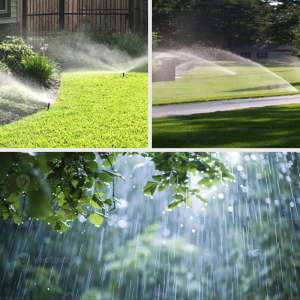Rainwater vs Irrigation: Why Plants Always Prefer a Natural Drink
If you’ve ever walked around the garden after a good downpour and thought everything looked greener, brighter, and somehow happier, you’re not imagining it. Rainwater really is the best drink your plants can get. While well water, bore water, and treated town supply certainly keep the garden alive, rainwater has a few natural advantages that artificial irrigation simply can’t replicate.
One of the big reasons rainwater is so beneficial is that it’s naturally soft and free from the salts, minerals, and chemicals found in many other water sources. There’s no chlorine, no fluoride, and none of the hard minerals like calcium and magnesium that can build up in soil over time. Without these added elements getting in the way, plant roots can take up nutrients much more efficiently.

Another quiet superpower of rainwater is its pH. It’s naturally slightly acidic, usually somewhere between pH 5.0 and 6.0, which makes it perfect for acid-loving plants like rhododendrons, azaleas, camellias, blueberries, and hydrangeas. This gentle acidity helps unlock nutrients in the soil and prevents issues like yellowing leaves caused by nutrient lock-up — something that can happen when plants are watered long-term with alkaline bore or town water supply.
Rainwater also brings with it a little bonus feed. As it falls, it absorbs tiny amounts of atmospheric nitrogen, which
 gives plants a subtle, natural boost. It’s one of the reasons everything seems so lush after a proper rain. And because rain falls so gently and evenly, it soaks deep into the soil, encouraging good root development and rehydrating the whole garden more thoroughly than many irrigation systems are able to.
gives plants a subtle, natural boost. It’s one of the reasons everything seems so lush after a proper rain. And because rain falls so gently and evenly, it soaks deep into the soil, encouraging good root development and rehydrating the whole garden more thoroughly than many irrigation systems are able to.
Another lovely benefit is that rainwater is rich in oxygen — much more so than water sitting in pipes or tanks. Roots need oxygen just as much as they need moisture, so this extra aeration helps keep them healthy and active.
That’s not to say bore water or town supply doesn’t have its place. Bore and well water are invaluable during dry spells, but their mineral content can be high, which means they can slowly raise your soil pH or leave behind salts that pots, in particular, don’t appreciate. Iron- or lime-rich water can also leave stains and cause some plants to struggle over time. Town water, while clean and convenient, often contains chlorine and can be slightly alkaline, which isn’t ideal for long-term use on sensitive or acid-loving plants.
This is why gardens — especially those with rhododendrons — always seem to respond so beautifully to natural rainfall. It’s clean, soft, nitrogen-rich, oxygenated, and just acidic enough to make nutrients more available. In short, it’s the perfect recipe for plant happiness.
If you rely on bore or town supply for most of your watering, don’t worry. You can still keep your garden in great shape. It just helps to use rainwater whenever you can, especially for your rhodos, azaleas, camellias, and anything growing in pots. A couple of rain barrels can make a huge difference. It’s also a good idea to mulch well, add plenty of organic matter, and check your soil pH once a year to keep everything balanced.
So while irrigation is essential — especially in summer — nothing quite compares to a natural drink from the sky. Your plants know it, and if you watch closely after the next rainfall, you’ll see exactly why.
